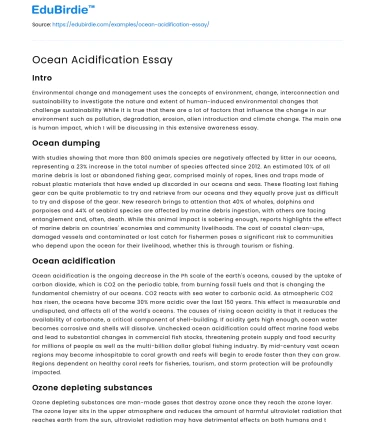Intro
Environmental change and management uses the concepts of environment, change, interconnection and sustainability to investigate the nature and extent of human-induced environmental changes that challenge sustainability While it is true that there are a lot of factors that influence the change in our environment such as pollution, degradation, erosion, alien introduction and climate change. The main one is human impact, which I will be discussing in this extensive awareness essay.
Ocean dumping
With studies showing that more than 800 animals species are negatively affected by litter in our oceans, representing a 23% increase in the total number of species affected since 2012. An estimated 10% of all marine debris is lost or abandoned fishing gear, comprised mainly of ropes, lines and traps made of robust plastic materials that have ended up discarded in our oceans and seas. These floating lost fishing gear can be quite problematic to try and retrieve from our oceans and they equally prove just as difficult to try and dispose of the gear. New research brings to attention that 40% of whales, dolphins and porpoises and 44% of seabird species are affected by marine debris ingestion, with others are facing entanglement and, often, death. While this animal impact is sobering enough, reports highlights the effect of marine debris on countries' economies and community livelihoods. The cost of coastal clean-ups, damaged vessels and contaminated or lost catch for fishermen poses a significant risk to communities who depend upon the ocean for their livelihood, whether this is through tourism or fishing.
Save your time!
We can take care of your essay
- Proper editing and formatting
- Free revision, title page, and bibliography
- Flexible prices and money-back guarantee
Ocean acidification
Ocean acidification is the ongoing decrease in the Ph scale of the earth's oceans, caused by the uptake of carbon dioxide, which is CO2 on the periodic table, from burning fossil fuels and that is changing the fundamental chemistry of our oceans. CO2 reacts with sea water to carbonic acid. As atmospheric CO2 has risen, the oceans have become 30% more acidic over the last 150 years. This effect is measurable and undisputed, and affects all of the world's oceans. The causes of rising ocean acidity is that it reduces the availability of carbonate, a critical component of shell-building. If acidity gets high enough, ocean water becomes corrosive and shells will dissolve. Unchecked ocean acidification could affect marine food webs and lead to substantial changes in commercial fish stocks, threatening protein supply and food security for millions of people as well as the multi-billion dollar global fishing industry. By mid-century vast ocean regions may become inhospitable to coral growth and reefs will begin to erode faster than they can grow. Regions dependent on healthy coral reefs for fisheries, tourism, and storm protection will be profoundly impacted.
Ozone depleting substances
Ozone depleting substances are man-made gases that destroy ozone once they reach the ozone layer. The ozone layer sits in the upper atmosphere and reduces the amount of harmful ultraviolet radiation that reaches earth from the sun, ultraviolet radiation may have detrimental effects on both humans and the environment such as inducing skin cancer, cataracts, distorting plant growths and damaging the marine environment. The substances depleting the ozone layer can and may include chlorofluorocarbons, hydrochlorofluorocarbons, hydrobromofluorocarbons, halons, methyl bromide, carbon tetrachloride and methyl chloroform, all of these substances have been used as refrigerant in commercial, ho vehicle air conditioners and refrigerators, foam blowing agents, components in electrical equipment, industrial solvents, aerosol for spray propellants and fumigants.
Conclusion
And while there may not be a definite solution to all of the oceans issues there are small things that everyone can do to try and help such as reduce your use of single-use plastics, recycle properly, participate in or organize a beach or river cleanup, support petitions for bans, avoid products containing microbeads and support organizations addressing plastic pollution.
Our World DinData
Surface plastic mass by ocean basin, 2013 Quantity of plastic waste floating at the ocean surface within each of the world's ocean or marine basins. This is measured in terms of the mass of particles ranging from small microplastics to macroplastics. It includes only plastics within surface waters (and not al depth or on the seafloor).






 Stuck on your essay?
Stuck on your essay?

